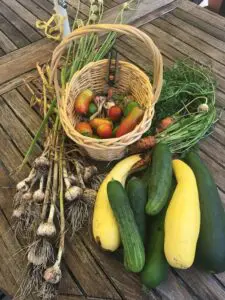Nurseries and plant sales will be stocked with veggie starts in the coming weeks, and we’re in the final days before the last frost date on May 15. As temperatures and soil warms, the next phase of planting a seasonal vegetable garden begins.

It’s OK if you don’t have a plan or didn’t start tomatoes from seed in February. There are still ample opportunities to have fresh and delicious homegrown food this summer no matter what your level of gardening experience. After surviving on grocery produce all winter, I had broccoli rabe recently from the farmers market and was reminded how vegetables grown locally and sustainably are almost a different species. It’s worth the effort.
Here are some things to consider in setting up a simple, yet productive, vegetable garden if you’re just starting now.
Days to harvest
These words on the plant tag denote how long you will have to wait for that tomato or pepper. With weather that is predictably less predictable — hotter, wetter, drier? — I’m placing my bets on the quickest turnaround. The less time that the plant is exposed to pests, diseases or stress, the better.
Tomatoes are a great example. There is early blight and late blight, a wind-borne pathogen. The time a plant needs to grow a tomato can vary from 40 to 90 days. Generally, cherry tomatoes can be picked more quickly than a beefsteak. The longer you wait for the tomato, the greater the risk of losing your plants to an issue beyond your control.
Maturity matters
Buy the largest plants you can find that look healthy. Check the roots to make sure they are loose and not bound in a tight ball or pushing through the pot.
Keep your plants close
Plant lettuce greens in containers near the house. I grow mine on the patio and it’s a joy to pop out and cut the leaves I want for a fresh salad. I start lettuce and arugula from seed because I can usually start eating it in six to seven weeks. I work with mainly loose-leaf varieties instead of the head lettuce you cut all at once.
Since lettuce prefers cooler temperatures and less sun, I move the pot if I need to.
Matters of size
Consider your space and how to get the most from it. Even if you’d love to have a supply of your own pumpkins to carve in October, these plants sprawl and take up a lot of real estate. Other plants that occupy large tracts are squash, corn, melons and cucumbers, depending on the type.
I plant cucumbers in spite of their logistical demands because my family loves them and we make quick pickles or canning pickles to extend the season. Gardens require attention and care throughout the summer and you should include the vegetables that bring the most happiness. Otherwise, what’s the point?
Include perennial herbs and vegetables
I look forward to the return of my chives every spring. They are a pop of flavor for many dishes.
Since it can take years before harvest, the best time to plant asparagus was last season, but start now anyway. Look for shoots that are labeled “two year” to get a crop in the second year after planting.
Other perennials to include are rhubarb, sorrel, sage, thyme and mint, if you’re careful to contain it. In the microclimates that are warmer in our area, kale and shallots could be perennial.
Avoid overabundance
Our family of three burns out if we have the same vegetable frequently so I keep it to a few plants of each and try to space them out through the season. Kale, spinach, collards and chard can go a long way with a few plants, and I max out the zucchini and summer squash at two plants each.
Roots
Carrots, radishes, potatoes, parsnips, onions and celeriac need space to be grown in quantities that make meals. Try square-foot gardening and divide a bed into sections using calculations of how many plants per area. For example, in this method, you could potentially squeeze in 16 carrots per square foot.
The sides
Now include some of your favorites. This could be eggplant, broccoli, okra, cabbage, celery or Brussels sprouts. If you have vertical space, plant runner beans or cucumbers and let them climb. It’s too late in the season for peas.

